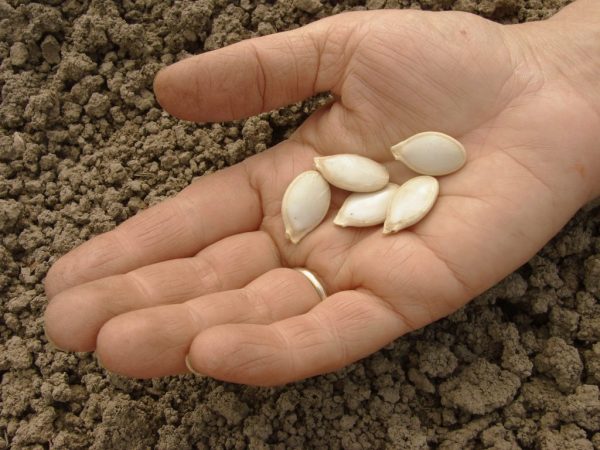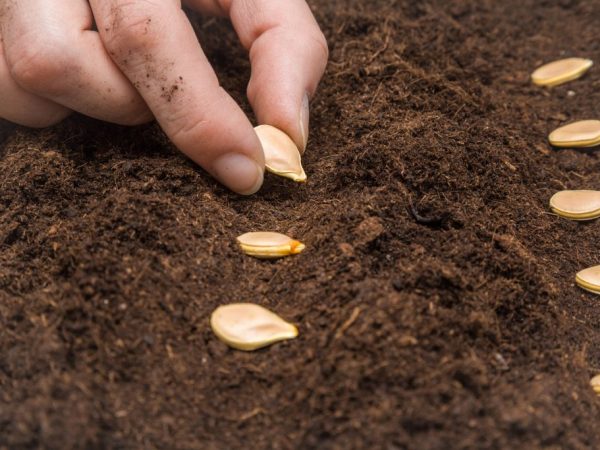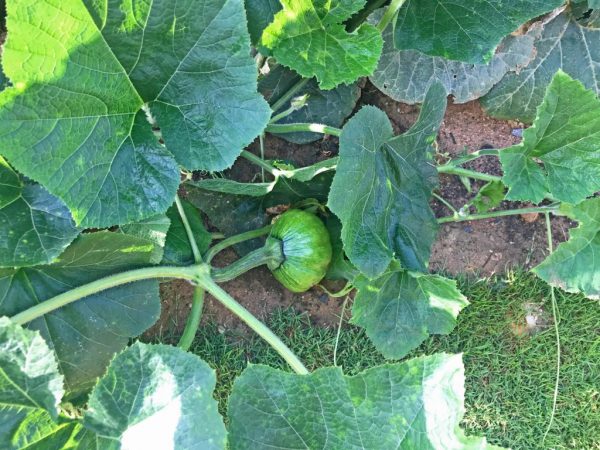Rules for growing pumpkin in the open field
Many gardeners today practice pumpkin cultivation in the open field. You can plant a vegetable in the garden not only in the garden, but also in a barrel, on trellises and in a bag. Some people successfully cultivate pumpkin seeds right on the balcony. The yield directly depends on the pre-planting preparation and subsequent care of the vegetable.

Rules for growing pumpkin in the open field
Breeding conditions
The heat-loving pumpkin has a powerful root system and a long stem that grows up to 7 m.Nourishment occurs through a branched root system, in which the central root grows to a depth of 6-7 m, and the lateral ones - up to 3-4 m. the structure is five-toed, bright green. The fruits form on the main stem.
The rules that must be observed when choosing the conditions for growing it depend on these features of a vegetable crop:
- temperature. Sown pumpkin seeds germinate in 2-3 days at a temperature of 30 ° C, germinate for a long time at 20 ° C and do not germinate at 10 ° C or lower. The optimal mode for further cultivation is 25 ° С during the day and up to 13 ° С at night. At this temperature, the vegetable crop quickly grows foliage, the area of which sometimes reaches 40 m², and intensively forms large fruits;
- humidity. In addition to warmth, pumpkin long roots require increased moisture, especially during the flowering stage. Properly organized watering is important here;
- lighting. A heat-loving vegetable crop requires a lot of sunlight, so the place for planting it must be chosen so that the sun gets there for 6 hours or more. It is better to plant the plant so that from the north it is protected from cold winds by a fence (fence, building wall, etc.). As the pumpkin grows, it will be able to act as a support for the whips;
- priming. A powerful root system is responsible for plant nutrition and does its job well in loose and fertile soils. A vegetable crop does not bear fruit well on heavy clayey soils, especially with a high level of groundwater, which soak its roots. Slightly acidic and slightly alkaline soils are acceptable;
- "Predecessors". Plant pumpkin well after beans, onions, cabbage and garlic. Vegetable crops grow and bear fruit poorly after carrots and tomatoes. You can grow corn, beets, beans and radishes in the neighborhood. Potatoes, cucumbers and salad greens do not affect the development of the vegetable in any way.
Cultivation methods
The classic way to cultivate pumpkin is to plant it in the garden. For sowing seeds and transplanting seedlings, it is better to make high beds with a width of 0.7 m. Each gardener chooses the length of the row independently.
Tall beds make it easier to take care of the plants afterwards.
Traditionally, pumpkin cultivation in the open field is done in this way:
- the pumpkin is planted in rows with a distance of 2-2.5 m between them and with a distance of 1 m between the bushes;
- pits are made 0.4 m wide, digging them to a depth of 0.3 m;
- the bottom of the holes is laid out with superphosphate and potassium sulfate (1 tbsp each), then filled with 1/3 with humus or compost, then a mixture of peat and turf in equal amounts and ½ cup of wood ash is poured;
- the remainder of the groove after sowing seeds and planting seedlings are covered with plain earth and watered.
In addition to the classic cultivation of pumpkin in the open field, today gardeners are successfully cultivating vegetables in other ways.
On the balcony
At home (on the balcony), ornamental pumpkin varieties are often grown, but some plant ordinary low-growing varieties. A feature of such cultivation is the need for artificial pollination by hand. Containers or pots with a volume of 45 liters or more are suitable for planting.
In a barrel
Unlike industrial cultivation or breeding as a business, summer residents have the opportunity to grow pumpkin for personal use on the site not in the garden, but in a barrel, installing it where it is convenient.
The advantage of growing pumpkin in a barrel is to save space on the backyard of a summer cottage, because lashes do not grow over the surface of the ground, but hang from the edges. Barrels are prepared in autumn:
- wooden or metal containers are installed in the right place;
- lay out in them layers of plant residues (foliage, etc.), then - grass and food waste;
- pour water over the layers and close the barrel with a lid.

The pumpkin can be grown in a barrel
In the spring, soil and sand are poured into the container and mixed. 1-2 plants are planted in each container.
The peculiarity of caring for barrel pumpkin is associated with faster drying of the soil compared to the ridge, so the bushes need to be watered more often.
In the bag
The technology of cultivation in a bag is similar to the method of cultivation in a barrel:
- a durable synthetic bag is filled with layers of plant residues;
- then they put it in the right place, preferably near the fence, which will become a support for the whips;
- 1 seed or seedling is planted in each bag.
On the trellis
For vertical cultivation on a trellis, a structure up to 2 m high is used, making it from wooden planks. The distance between the bushes is reduced to 0.3 m due to the direction of growth of the culture vertically upwards.
The prerequisites for growing on a trellis machine are pinching bushes, pinching and tying whips and fruits to supports.
The method of growing pumpkin on trellis equipment is not suitable for varieties that produce large fruits.
Pre-planting preparation
To grow a healthy and high-quality pumpkin, it is necessary to carry out a number of preparatory measures before planting.
The soil
A plot for planting a pumpkin is prepared in the fall:
- when digging the soil, organic matter is introduced - humus (5 kg per 1 m²) or manure (7 kg per 1 m²);
- mineral nutrition is added to organic matter - superphosphate (30 g per 1 m²), potassium chloride (15 g per 1 m²);
- provide the soil with the required looseness - they bring in peat or coarse river sand.
Seeds
Generally, seed preparation includes calibration, disinfection, pre-germination and hardening.
Calibration
Initially, the seeds are selected according to their appearance, removing too thin, insufficiently filled and having mechanical damage. Then they are sorted by soaking in a saline solution. Those that remain at the bottom are suitable for sowing. Seeds that have surfaced are not used, because they have the lowest germination rates.
Disinfection
Treatment of seeds with a weak solution of potassium permanganate increases the resistance of plants to diseases and helps them withstand the attack of pests. Additionally, the seeds can be soaked in a growth stimulant, for example, "Epine", which will increase their germination.
Germination
The seeds selected for sowing are germinated, for which they are placed in water heated to 40-50 ° for 3-4 hours. Then they are wrapped in a moistened cloth and left to peck, preventing it from drying out.
Hardening
Hardening helps to increase the resistance of future sprouts to temperature changes. For this purpose, the seeds are kept in a damp cloth in a refrigerator at a temperature of 4 ° C for 3-5 days.
Sowing seedlings

Seeds must be hardened before planting.
When cultivating pumpkins using seedlings, seeds are planted at home in peat cups. They can be replaced with plastic ones, but later you will need to be careful when removing the seedlings. The optimal size of containers is from 10 × 10 cm.
The number of seedlings is calculated so that for every 2 m² there are no more than 5-6 seedlings.
For seedlings, the substrate is taken ready-made, intended for growing pumpkin seeds, or they make it independently from peat and river sand taken in equal proportions. They fill containers and sow the hatched seeds, burying them in the soil mixture by 2-3 cm.
After sowing, the substrate is sprayed with water from a spray bottle. For the first 3 days, containers are placed in a place where the temperature is maintained at 25-30 ° C.
Properly prepared seeds, while maintaining the temperature at the proper level, sprout for 3-4 days.
After the emergence of seedlings, the containers are rearranged to a cooler place, where the temperature is 18-25 ° C, gradually lowering it to 15-18 ° C. This will prevent the seedlings from pulling out.
After 2 weeks of growth, the seedlings are fed with a mullein diluted with water in a ratio of 1:10 or nitrophos in the dosage prescribed by the instructions.
In the third week of growth, the seedlings are usually ready to be transplanted to the garden bed. By this time, the seedlings have 3 leaves each.
Disembarkation dates
Pumpkin is grown by seed or seedling method. It all depends on the region of cultivation. So, if in the southern regions you can sow seeds directly into an open bed, then in the northern regions (Siberia), as well as in the Leningrad region, in the Urals, for growing pumpkin in the open field, it is better to first germinate seedlings. It is worth purchasing zoned varieties.
Approximate terms:
- seeds are sown after May 15-20, when the soil warms up to a depth of 15 cm and there is no threat of sudden night frosts. At the same time, residents of the northern regions need to additionally create protection for plants - cover sowing sites with cut plastic bottles, make a single film shelter for the entire ridge or plant seeds in a greenhouse;
- seedlings are transplanted into open ground at the age of 22-25 days, this period is taken into account when sowing seeds at home.
Care
The pumpkin does not require special care. The main agrotechnical rule for a vegetable crop is regular watering. For a good harvest, feeding the pumpkin is also important. Pruning and grafting will help the plant achieve the best results.
Vaccinations
Many gardeners are trying to vaccinate the pumpkin. The secret of this procedure is simple: they make such a "shot" to increase the resistance to diseases and cold weather of other plants, such as watermelon or melon.
It should be inoculated at an air humidity of 83-85% and a temperature of about 25-29 ° C. Inoculation is often carried out by approaching through the epidermis or into the lateral incision of the stem (with tongues).
When grafted by rapprochement across the epidermis:
- take plants aged 7 days;
- remove the layer from the stems in the form of a strip to a depth of 1 mm and a length of 3 cm;
- the sections are connected and insulated with polyethylene;
- after accretion, the bottom of the rootstock and the top of the scion are cut off - as a result, a root from a pumpkin and a stem from another plant are obtained.
When inoculation through rapprochement with tongues:
- tongues of 2 cm are cut on the stems, making them from the pumpkin from top to bottom, and from another plant from bottom to top;
- the resulting latch is connected and wrapped in polyethylene;
- after accretion, the roots of a plant grafted onto a pumpkin are cut off.
Pruning

Excess shoots must be removed
A feature of the pumpkin is the intensive growth of lateral shoots. They draw on food, take up a lot of space and act as breeding grounds for diseases. They begin to graze the pumpkin at the very beginning of the emergence of shoots.A plant is usually formed into one stem, cut off excess shoots and leave 2-3 ovaries and 3-4 leaves.
The top is pinched so that the central stem does not stretch up. Additionally, old foliage and barren flowers that have turned yellow or covered with spots or bloom are cut off.
Watering
A plant with an extensive leaf mass and a powerful root system requires a large amount of moisture, which it actively consumes from the soil. Watering is especially important at the stage of flowering and fruit formation.
The optimum water temperature for irrigation is 20 ° C. It is impossible to water the pumpkin with cold water, because she can shed the ovaries.
Before the initial loosening and hilling, the pumpkin is watered 1-2 times, after which a break for 2-3 weeks. When the fruits ripen, watering is reduced, and 20 days before the planned harvest date, it is stopped. The total number of these procedures for the entire growing season is 5-10 times.
After watering, the soil in the area of the roots is loosened to provide them with oxygen. Simultaneously with loosening, the emerging weeds are removed.
Top dressing
The pumpkin feeding scheme includes up to 5-6 fertilizers:
- the first time it is fertilized when the 5th leaf appears in the sprouts;
- the second - with the formation of lashes;
- subsequent feeding is carried out at intervals of 2 weeks.
For pumpkin, nitroammofoska is suitable, the dosage of which is increased gradually: they start from 10 g per 10 l and with each subsequent feeding, the amount of fertilizer is increased by 5 g for the same amount of water.
During the formation and ripening of fruits, it is additionally required to fertilize the pumpkin with wood ash (200 g per 10 l of water).
Among the folk remedies for feeding vegetables is yeast fertilization. Baker's yeast, diluted with water in a ratio of 1: 5, increases the immunity of the pumpkin and is suitable for newly transplanted seedlings: with their help, it quickly adapts to new conditions.
Harvesting and storage
They try to harvest before the first cold weather appears. The frozen pumpkin begins to rot quickly. The ripeness of the fruit is determined by pressing on its bark: when the surface of the crust hardens, no pressure marks remain on it.
Additional signs of the ripeness of a vegetable are the blanching of the color of its peel, yellowing and dryness of foliage, and stiffness and dryness of the stalk.
The vegetable is cut from the shoot with a sharp knife, leaving a stump of 4-5 cm.

Vegetables are harvested by cutting off the stalk
Only whole fruits that do not have mechanical damage are taken for storage. The shelf life of most pumpkin varieties is about 3-4 months, but it can vary depending on the species:
- large-fruited is stored for about 9 months;
- nutmeg is able to lie and retain its taste and useful properties for up to 2 years.
Optimal storage conditions are in a cool, dark place.
Diseases
The pumpkin is hardy, but sometimes it is affected by certain diseases. The most common are:
- powdery mildew - the foliage is covered with a white bloom;
- peronosporosis (downy mildew) - the leaves do not turn white, but are covered with yellow dry spots, which then become dark in color;
- anthracnose - foci depressed inward and a pink-white bloom appear, subsequently holes in the form of a cobweb are formed.
Treatment
When the first signs of disease are found, when the leaves have turned white or covered with yellow spots, they are treated by foliar spraying with fungicidal agents.
Against infections, the bushes are sprayed with such solutions: copper sulfate (2 g) or potassium permanganate (3 g) per 10 liters of water. Medical treatments are carried out with Bordeaux liquid with a concentration of 1%.
Prophylaxis
The main prevention of diseases is reduced to the observance of agricultural techniques, including:
- properly organized watering;
- trimming excess foliage;
- removal of plant residues containing pathogens and pest larvae;
- compliance with crop rotation;
- pre-sowing disinfection of seeds.
There are many ways to grow a pumpkin.In addition to cultivation in the garden, vegetables are planted in barrels, bags and grown on a trellis, saving space in the garden. Ornamental varieties are grown on the balcony.
To obtain a crop, it is necessary to create favorable conditions for growth for the vegetable crop and take care of it properly. Harvested vegetables are stored for 3 months to 2 years.

